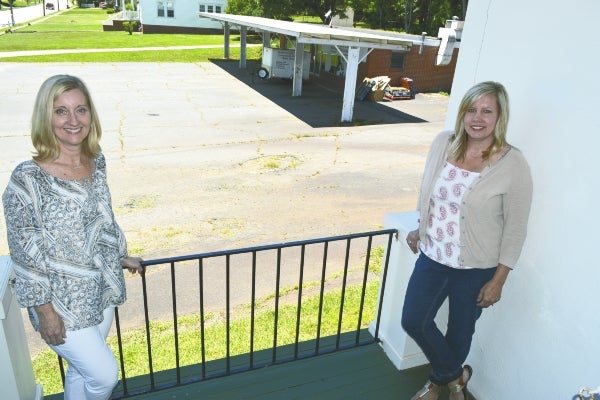To do more: Main Street Mission seeks expansion through capital campaign
Published 12:05 am Friday, June 17, 2016

- Anne Corriher, left, and Hope Oliphant stand on the porch at Main Street Mission. The former laundromat beside the mission will become the organization’s new food pantry, so that they may expand programs in the existing building that help clients work their way out of poverty.
By Susan Shinn
For the Salisbury Post
CHINA GROVE — Hope Oliphant glances around the building’s interior, gutted to the cinder block walls. A few metal chairs are still attached to the back wall. Many ceiling tiles hang at precarious angles.
“It’s pretty ugly in here right now,” Oliphant admits.
Not for long.
Main Street Mission, located at 306 S. Main St. in downtown China Grove, has launched a capital campaign to renovate and expand the former laundromat next door. The 1,500-square-foot space will become a 5,000-square-foot food pantry. But the pantry is a means to an end, explains Anne Corriher, the organization’s executive director. Oliphant serves as community outreach coordinator.
The mission can then use its existing building — which has over the years served as a church, funeral home and private home — to expand programs which work to help lift clients out of poverty.
Tom Smith, a China Grove native and former CEO of Food Lion, made the lead gift for the $400,000 campaign.
Fred Corriher is serving as the campaign’s informal fundraiser. Corriher brought Smith to the facility for a recent tour.
“I was totally impressed with the job they’re doing there with people in need,” Smith says. “Not only helping them with food, but helping them to prepare to find a job and improve their lives.”
“I’m so pleased with Tom’s gift, and I hope others in the community will join us in this endeavor,” Fred Corriher says.
Architect Pete Bogle completed the design, and his associate, Natalie Morgan, is working with the mission on the final stages of the project.
The laundromat will be transformed into a freestanding food pantry, with a welcome desk, interview stations, and plenty of much-needed storage for food donations. The walk-in coolers and freezers will be moved down the hill from next door. There will be room for pallets collected from the Second Harvest food bank, and a garage door will be installed to accommodate trucks that bring in food.
“It’ll be so nice,” Oliphant notes. “Yes, the capital campaign is about providing more space for food and clothing, but it’s more about providing programs.”
Anne Corriher agrees.
“We’re doing two things in one facility at the moment,” she says, “and it’s just not adequate space. We don’t have enough space for our food pantry, and we don’t have enough space for programs.”
To be considered stable, a person must possess eight of 11 basic resources. Poverty, Oliphant says, is the extent to which a person does without resources. Those resources are financial, emotional, mental, language, social capital, physical, spiritual, integrity/trust, motivation/persistence, relationships/role models, and knowledge of the hidden rules of economic classes.
“Our dream is to offer programs to address all of those resources,” Oliphant says. “We want to have offerings by people in the community who have those gifts to share with our clients, or, as we call them, our neighbors.”
The mission offers a 15-week course called the Bridge Builders program, based on the book, “Bridges Out of Poverty.”
“We hope through Bridge Builders that this program can be a door into the next phase of their lives,” Corriher says.
For example, she notes, a family in crisis may get food from the pantry, but then go next door to participate in programs that will help them address their current living situation.
Because of crisis situations, and because there are people who must live on Social Security or disability checks, Oliphant says, “We’re always going to have people coming here for food. But we also want to help people stand on their own two feet.”
With more room for programs at the existing building, Anne envisions offering classes in yoga, spinning, knitting, sewing, writing workshops, GED prep, ESL classes, a walking club, Bible studies, and much more — to the entire community.
When someone completes the Bridges program, they’re assigned to a Hope Team of folks who continue to walk with them as they continue to improve their lives. Those meetings can take place in the existing facility and enable the Hope Teams to expand as well.
“We want to continue to build those resources,” Hope says. “It’ll be a holistic approach to healing.”
A new, four-week “Becoming Real” class was recently offered to those who have completed the Bridges classes. That helps them transition from the classes to working with their Hope Teams, Corriher says.
Thus far, 30 people have graduated from the Bridge Builders program since it began two years ago, Oliphant says. “It’s a big commitment, but when the class ends, our students are sad. They have formed community.”
“There are so many layers of need in our community,” Corriher continues. “People who have lived a stable life somehow become isolated. Life happens.”
She hopes to select a general contractor by the end of August, with the new facility set to open in early spring.
Because the motto of Main Street Mission is “One Can Do More,” campaign organizers are inviting people to give $20, and invite a friend to do the same. For more information about the capital campaign, visit www.mainstreetmission.org or call 704-855-2909.
Freelance writer Susan Shinn lives in Salisbury.




